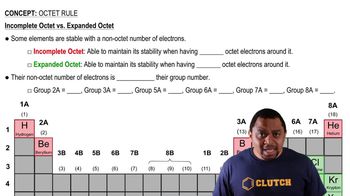Here are the essential concepts you must grasp in order to answer the question correctly.
Lewis Structures
Lewis structures are diagrams that represent the bonding between atoms in a molecule and the lone pairs of electrons that may exist. They use dots to represent valence electrons and lines to represent bonds between atoms. Understanding how to draw Lewis structures is essential for visualizing molecular geometry and predicting the behavior of molecules.
Recommended video:
Lewis Dot Structures: Ions
Expanded Octet
An expanded octet refers to the ability of certain elements, particularly those in the third period and beyond, to accommodate more than eight electrons in their valence shell. This occurs because these elements have d orbitals available for bonding. In the case of PF5, phosphorus can form five bonds, thus exceeding the octet rule.
Recommended video:
Molecular Geometry
Molecular geometry describes the three-dimensional arrangement of atoms within a molecule. It is influenced by the number of bonding pairs and lone pairs of electrons around the central atom, which can affect the molecule's shape and reactivity. For PF5, the geometry is trigonal bipyramidal, which is crucial for understanding its chemical properties and interactions.
Recommended video:
Molecular Geometry with Two Electron Groups
 Verified step by step guidance
Verified step by step guidance


